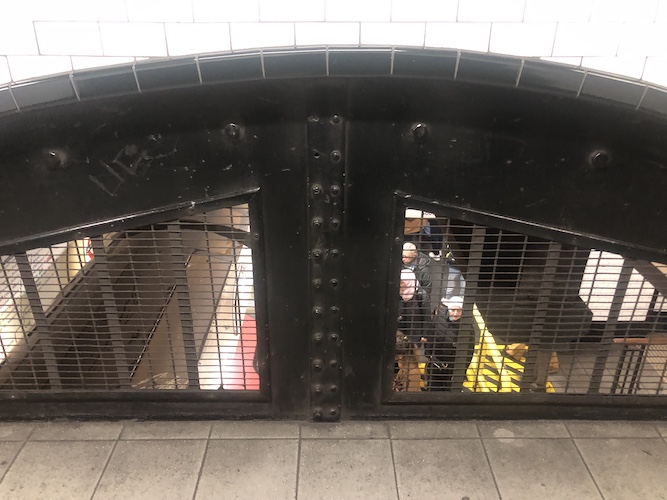The thrill was the more thrilling for having forgotten about it. Reacquaintance occurred due to impatience at Angel, where I was too restless to wait for the Edgware train and took the High Barnet instead. No time was saved, but at least I would be on the move and could switch over at Camden Town, where the branches of the Northern line meet. Thus was the thrill re-lived.
It came when I was changing platforms, striding along a connecting walkway. There’s a grille in the corridor wall. I glanced at it, looked through it, and saw below it the top of a stationary tube train. Passengers entering and exiting it too. It was one of two southbound platforms (number 3 and 4) , each positioned beneath the two northbound ones (1 and 2) that I was hurrying between. I stopped for long enough to take a photo. Then I remembered that I’d forgotten getting a kick out of this sight before.
The thrill lies partly in the absurd but enjoyable delusion that your vantage point is secret, but mostly in the reminder about why the tracks and platforms are arranged in such a way, and why Camden Town station is a funny shape. Wikipedia explains that it is all to do with the two roads up above – to be precise, the widths of and geometrical relationship between Chalk Farm Road and Kentish Town Road, whose southern ends begin at the same point, forming part of the same teeming junction as Camden High Street and Parkway.
When construction of what was then the Charing Cross, Euston and Hampstead Railway go going, at the start of the 20th Century, it followed the routes of the two roads, thereby avoiding any need for the project’s American financier, Charles Yerkes, and his many foreign investors to pay compensation for disruption to owners of land on either side of them. The shape of the station, one of prolific Underground architect Leslie Green’s designs, fits the “V” the roads form at their shared root.
When the station was opened in 1907 – by future Prime Minister David Lloyd George, at that time President of the Board of Trade – the railway’s dual northern prongs terminated before their current endpoints. They were later connected straight to the West End and the City, entailing yet more ingenious engineering and resulting in multiple junction tunnels beneath Camden High Street. The Northern line name was formally adopted in 1937.
You will have deduced that I don’t pass through Camden Town station that often, and when I do I rarely stop to change trains. But I think about it frequently, largely for nostalgic reasons concerning Camden market, music and the eclectic demographic of wearers of Doctor Martens boots. Frightgeist starlet Mo emerges from it en route to her job at a vintage clothing shop. She and fellow starlet Mo travel from it all the way to Morden in the deepest south, where ocean-going art deco and a landmark mosque await. Next time you are restless at Angel, do what I did.
John Vane’s London novel Frightgeist can be bought here.
OnLondon.co.uk provides unique coverage of the capital’s politics, development and culture with no paywall and no ads. Nearly all its income comes from individual supporters. For £5 a month or £50 a year they receive in-depth newsletters and London event offers. Pay via any Donate link on the website or by becoming a paying subscriber to publisher and editor Dave Hill’s Substack.

